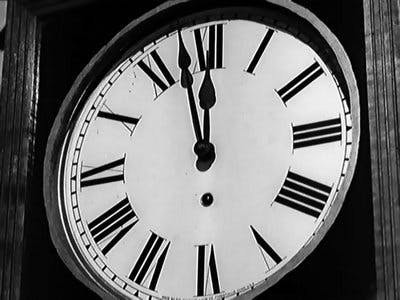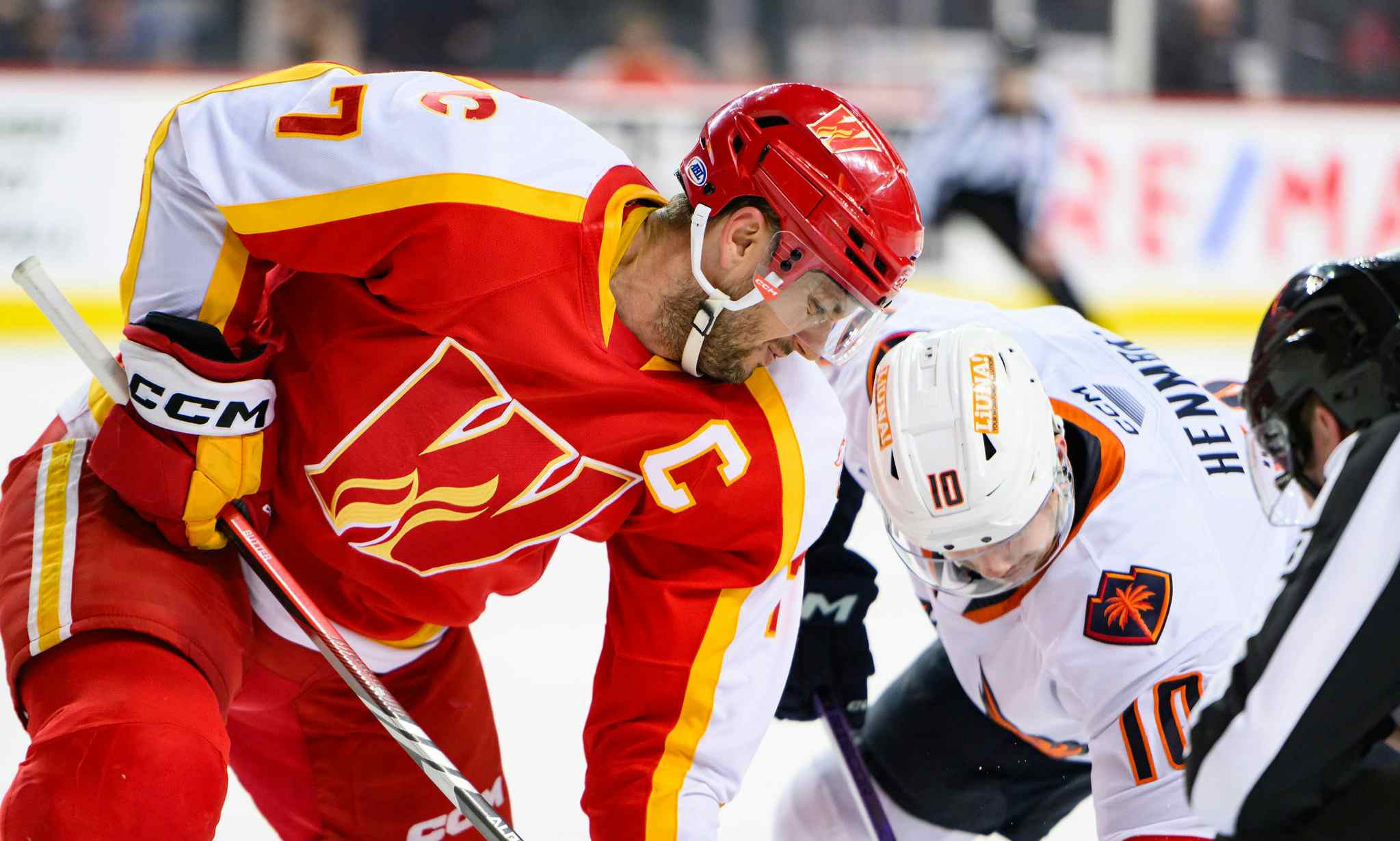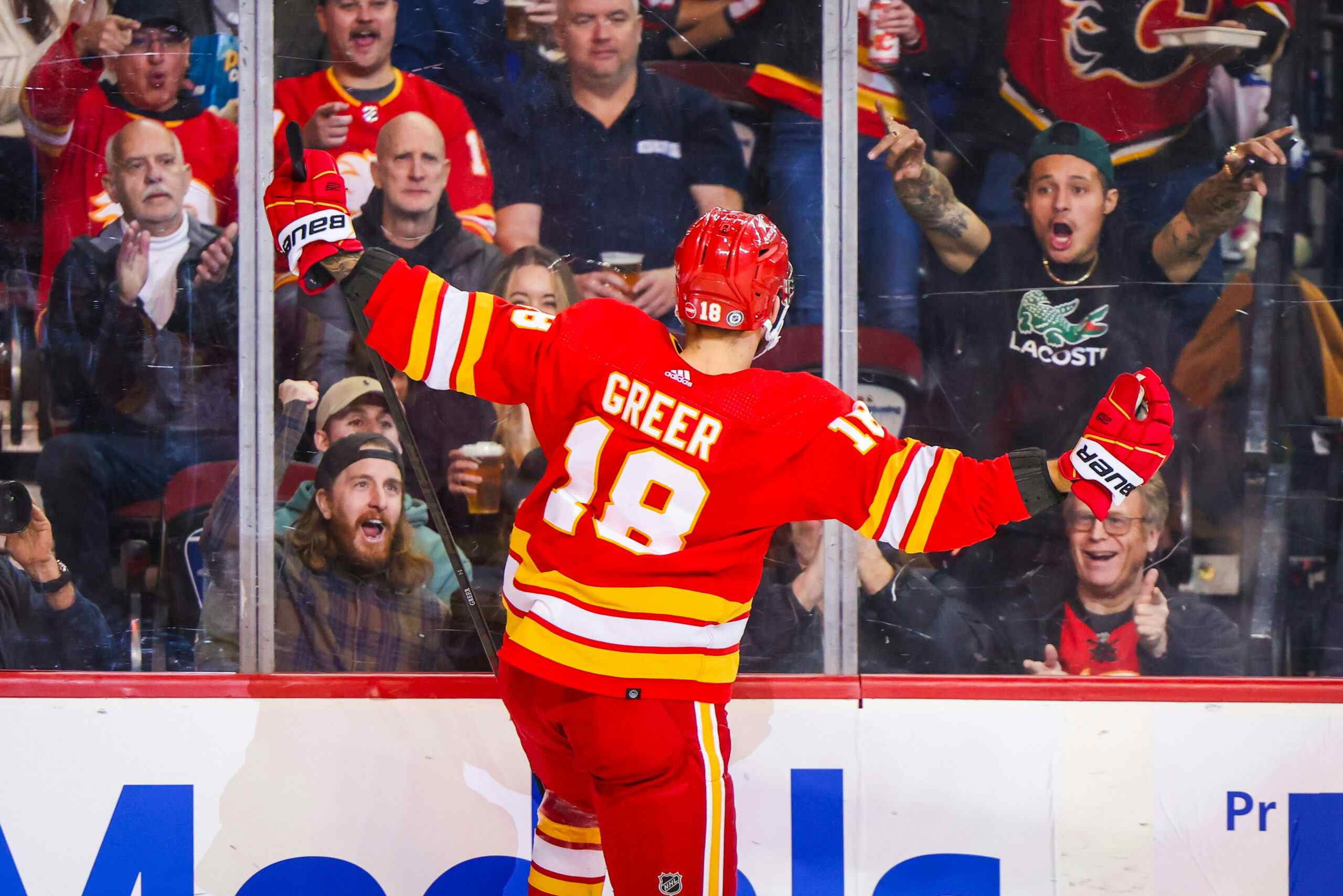Will Cammalleri Come to Life?
Mike Cammalleri is back! But he has just 2 points – both goals – and is -6 in 8 games. This doesn’t seem like the only Flame to beat Jarome Iginla in the goal-scoring race since Valeri Bure in 1999-2000. What gives?
Let’s take a look at his career stats, including some of the more advanced statistics available since the 2007-08 season.
Year Team GP G A PTS TOI:ES/PP/SH QoC OZ% RC PDO 2002-03 L.A. 28 5 3 8 11.5 2.7 0.0 Not Available 2003-04 L.A. 31 9 6 15 10.7 2.4 0.0 Not Available 2004-05 Lockout 2005-06 L.A. 80 26 29 55 10.7 5.3 0.7 Not Available 2006-07 L.A. 81 34 46 80 13.2 4.7 0.2 Not Available 2007-08 L.A. 63 19 28 47 14.3 4.0 0.2 -0.3 56.1% 11.4 972 2008-09 Calgary 81 39 43 82 13.4 4.0 0.0 0.2 58.1% 12.2 997 2009-10 Montreal 65 26 24 50 16.5 2.9 0.0 0.3 48.0% 8.6 1018 2010-11 Montreal 67 19 28 47 14.7 3.1 0.7 0.6 52.2% -6.9 1008 2011-12 Mtl/Cgy 46 11 13 24 14.1 3.1 0.9 1.2 53.5% -1.9 977
Glossary:
TOI: Time on Ice per game, Even-Strength, Power Play, Short-handed
QoC: Shot-Based Quality of Competition metric (0.0 is average)
OZ%: Percentage of shifts started in the offensive zone (50.0% is average)
RC: Relative Corsi (An attempted shot-based plus/minus per 60 minutes, relative to teammates)
PDO: On-ice shooting percentage plus save percentage (Tends strongly to 1000)
QoC: Shot-Based Quality of Competition metric (0.0 is average)
OZ%: Percentage of shifts started in the offensive zone (50.0% is average)
RC: Relative Corsi (An attempted shot-based plus/minus per 60 minutes, relative to teammates)
PDO: On-ice shooting percentage plus save percentage (Tends strongly to 1000)
There are a few trends that pop out since his great 2008-09 season:
– He has missed 15-17 games in the previous two seasons, injuries could be affecting his play
– He’s getting 3 minutes of power-play time per game instead of 4 to 5+
– He’s being used as a penalty killing option (albeit a depth one) for only the 2nd time in his career
– He’s facing increasingly more difficult competition
– He’s starting in the offensive zone 48%-53.5% of the time instead of 56.1%-58.1% of the time
– Perhaps as a consequence of the previous two points, his overall shot-based performance has been going down
– He’s had his roughest season luck-wise since his equally disappointing final season as a King
– He has missed 15-17 games in the previous two seasons, injuries could be affecting his play
– He’s getting 3 minutes of power-play time per game instead of 4 to 5+
– He’s being used as a penalty killing option (albeit a depth one) for only the 2nd time in his career
– He’s facing increasingly more difficult competition
– He’s starting in the offensive zone 48%-53.5% of the time instead of 56.1%-58.1% of the time
– Perhaps as a consequence of the previous two points, his overall shot-based performance has been going down
– He’s had his roughest season luck-wise since his equally disappointing final season as a King
It seems pretty obvious that his decrease in scoring can be explained by age mixed with injuries, and by being used in less advantageous situations.
It’s also arguable that he was never an elite player. He deservedly established himself as a power play specialist, scoring 60 power play goals in the four seasons after the lock-out, including finishing 2nd in the NHL with 19 as a Flame. Only five players managed more power play goals over that period: Alex Ovechkin, Ilya Kovalchuk, Dany Heatley, Teemu Selanne and Tomas Vanek. Unfortunately he has just 14 in the three seasons since then.
If he’s not an elite forward, then how did he get a five-year, $6.0 million-per-year deal with Montreal in 2009-10, how did he get originally traded to Calgary for a 1st round pick (the one used on Jake Gardiner) despite contract disputes, a long slump and a rib injury, and how come it cost another 2nd rounder and Rene Bourque to get him and his crazy contract back?
Right on Time

The answer is this: it’s not what Mike Cammalleri is done, it’s when he’s done it.
– At the University of Michigan as a teen he twice made the all-star team, and factored in all three goals while playing in front of the largest outdoor game in history (to that date).
– He scored 11 goals and 17 points in 14 games in his two seasons in the World juniors, being named the tournament’s best forward the 2nd year (but left with bronze and silver – a major disappointment for a Canadian)
– Despite his small stature (he’s 5’9") he was drafted in the 2nd round by the Los Angeles Kings
– Led the AHL with 46 goals and a franchise record 109 points during the lock-out, finishing 2nd to Jason Spezza in the scoring race.
– Scored the first ever regular season NHL goal in Europe in 2007 when the Kings opened the season in London.
– In 2006-07 he won the Bill Libby award by the local media as the Kings’ most valuable forward
– His only NHL fight was in 2009-10, knocking down David Krejci http://www.hockeyfights.com/fights/99970
– Everybody remembers Jaroslav Halak’s playoff heroics in 2009-10, but Mike Cammalleri led the post-season with 13 goals in 19 games, tying a Montreal franchise record (which isn’t easy to do) with 7 goals in one series.
– He’s 5th among active players in play-off goals per game (behind Ovechkin, Kessel, Bergenheim and Umberger, one notch above Iginla himself)
– He’s 7th among active players in play-off points per game (behind Ovechkin, Crosby, Malkin, St. Louis, Jagr and Kane)
– He scored the 20,000th goal in Montreal’s franchise history
– This year he scored the first regular season goal at Winnipeg’s MTS Centre
– He scored 11 goals and 17 points in 14 games in his two seasons in the World juniors, being named the tournament’s best forward the 2nd year (but left with bronze and silver – a major disappointment for a Canadian)
– Despite his small stature (he’s 5’9") he was drafted in the 2nd round by the Los Angeles Kings
– Led the AHL with 46 goals and a franchise record 109 points during the lock-out, finishing 2nd to Jason Spezza in the scoring race.
– Scored the first ever regular season NHL goal in Europe in 2007 when the Kings opened the season in London.
– In 2006-07 he won the Bill Libby award by the local media as the Kings’ most valuable forward
– His only NHL fight was in 2009-10, knocking down David Krejci http://www.hockeyfights.com/fights/99970
– Everybody remembers Jaroslav Halak’s playoff heroics in 2009-10, but Mike Cammalleri led the post-season with 13 goals in 19 games, tying a Montreal franchise record (which isn’t easy to do) with 7 goals in one series.
– He’s 5th among active players in play-off goals per game (behind Ovechkin, Kessel, Bergenheim and Umberger, one notch above Iginla himself)
– He’s 7th among active players in play-off points per game (behind Ovechkin, Crosby, Malkin, St. Louis, Jagr and Kane)
– He scored the 20,000th goal in Montreal’s franchise history
– This year he scored the first regular season goal at Winnipeg’s MTS Centre
And remember how his time in Montreal came to a close – shortly after getting booed by the home team fans after a 3-0 loss to the St. Louis Blues. "I can’t accept that we will display a losing attitude as we’re doing this year. We prepare for our games like losers. We play like losers. So it’s no wonder why we lose."
Mike Cammalleri is a competitor. He played hard as a teenager, he played hard in the AHL, he played hard for the Kings in 2008-09, he plays hard with the man advantage, he plays hard in the play-offs, and yes, he has always played hard for the big contracts.
The bigger the spotlight, the brighter he shines. Whether it’s the largest outdoor game in history, the NHL’s first game in Europe, Winnipeg’s first game, or (of course) the NHL play-offs, Mike Cammalleri has stepped up his game.
Whether that’s a persistent character trait or merely a fortunate coincidence, it’s the reason why he has been viewed as (and paid like) an elite player – he has produced at the elite level when it counted.
While he doesn’t play elite hockey over the long-term, and certainly hasn’t been playing elite hockey in his 8 games back in the Flaming C, Calgary’s front office obviously believes that he’s the type of player who can help them in their most desperate of situations.
We’ve painted a picture of an ultra-competitive skill player – he won’t hit or block shots, but plays best when the chips are down and the spotlight is on him. Whether he’ll rise to the challenge or not isn’t a question we can answer with facts and statistics, because it’s a matter of character.
There’s no questioning Mike Cammalleri’s character. He’s a Jewish descendant of Holocaust survivors on his maternal side, Sicilian on his paternal side, and is said to have very strong family ties. He won the Jean Beliveau trophy last year for his local contributions to such organizations at the Starlight Children’s Foundation, World Vision, SickKids Foundation and families of the armed forces (follow him on Twitter @MCammalleri13). n his personal life he clearly believes in helping people get a fighting chance, and so far that has also translated into his hockey life too.
Would I bet on Mike Cammalleri coming back to life and leading the Flames to overachieve to the extent that would be required for that last play-off position? No way – I’m a numbers guy. But it’ll be an interesting stretch of hockey to watch.
Recent articles from Robert Vollman





